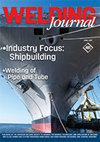316L不锈钢低磁导率焊缝的研制
IF 1.4
3区 材料科学
Q2 METALLURGY & METALLURGICAL ENGINEERING
引用次数: 0
摘要
奥氏体不锈钢常被用作粒子加速器真空室的结构材料。它也是高能、高功率粒子加速器超导射频腔氦容器的强有力候选建筑材料。奥氏体不锈钢应用于粒子加速器的主要限制之一是其焊缝的磁导率相对较高。本文介绍了采用ER型316L不锈钢填充金属,通过在氩气保护气体中控制加氮,获得316L不锈钢低磁导率气体钨极电弧焊的实验研究。结果表明,在氩气保护液中加入1.5%氮气后,316L不锈钢焊缝的磁导率与母材相近。焊缝在室温和液氦温度(4 K)下均符合美国机械工程师协会锅炉和压力容器规范(BPVC)的冲击试验要求,具有良好的强度和塑性。该技术对制造符合BPVC标准的316L不锈钢真空室和粒子加速器压力容器(包括超导射频腔氦容器)具有重要意义。本文章由计算机程序翻译,如有差异,请以英文原文为准。
Development of Low-Magnetic-Permeability Welds of 316L Stainless Steel
Austenitic stainless steel is often used as the construction material for particle accelerator vacuum chambers. It is also a strong candidate construction material for helium vessels of superconducting radiofrequency cavities of highenergy, high-power particle accelerators. One of the major limitations of austenitic stainless steels for their application in particle accelerators is the relatively higher magnetic permeability of its welds. The present paper describes an experimental study to obtain a low-magnetic-permeability gas tungsten arc weld of 316L stainless steel while using ER 316L stainless steel filler metal through controlled addition of nitrogen in the argon shielding gas. It was demonstrated that 316L stainless steel welds, made with the addition of 1.5% nitrogen in the argon shielding gas, were associated with magnetic permeability close to that of the base metal. The welds exhibited good strength and ductility in addition to qualifying the impact test requirement of the American Society of Mechanical Engineers Boiler & Pressure Vessel Code (BPVC) for operation at room temperature and liquid helium temperature (4 K). The technique is important for the fabrication of BPVC-compliant 316L stainless steel vacuum chambers and pressure vessels of particle accelerators, including helium vessels of superconducting radiofrequency cavities.
求助全文
通过发布文献求助,成功后即可免费获取论文全文。
去求助
来源期刊

Welding Journal
工程技术-冶金工程
CiteScore
3.00
自引率
0.00%
发文量
23
审稿时长
3 months
期刊介绍:
The Welding Journal has been published continually since 1922 — an unmatched link to all issues and advancements concerning metal fabrication and construction.
Each month the Welding Journal delivers news of the welding and metal fabricating industry. Stay informed on the latest products, trends, technology and events via in-depth articles, full-color photos and illustrations, and timely, cost-saving advice. Also featured are articles and supplements on related activities, such as testing and inspection, maintenance and repair, design, training, personal safety, and brazing and soldering.
 求助内容:
求助内容: 应助结果提醒方式:
应助结果提醒方式:


